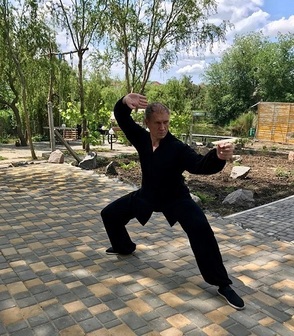I'd be happy to help in any way that I can. Just let me know...
Regarding Wudang style, I have to admit that I know little about it as it is not typically generally included in the lineage of classic styles that all derive from the Chen style. The following site has a good summary of those styles (https://www.realtaichiuk.com/tai-chi-lineage.html). I suspect that all of the schools that teach some form of "Wudang" style are simply based on a different historical lineage overall. From what I have seen, many of them seem to share similarities in terms of low, deep stances; expansive, flowing movements, etc. Perhaps others here that practice a form of Wudang style can elaborate. I would be very interested to learn more as well.
The difficulty is that, like so many martial arts styles, everyone likes to claim that their style is the most authentic, etc. That said, even within one particular style you can find so many variations on the standard forms. As there are many martial applications for each posture and so many different body types to account for, this makes perfect sense. I've always found that the best teachers take an open-minded approach to practice and not a "my way or the highway" approach. In any given lineage, the form will evolve over time as each teacher/student makes their own subtle, yet practical adjustments to the form. If they make significant changes, that is when it may be said that a new form/variation has been created (e.g., when Cheng Man-Ching created his own shortened version of the Yang style).
I'll end my ramble here...
Gassho,
Seikan
-stlah-
(apologies for running long)
Regarding Wudang style, I have to admit that I know little about it as it is not typically generally included in the lineage of classic styles that all derive from the Chen style. The following site has a good summary of those styles (https://www.realtaichiuk.com/tai-chi-lineage.html). I suspect that all of the schools that teach some form of "Wudang" style are simply based on a different historical lineage overall. From what I have seen, many of them seem to share similarities in terms of low, deep stances; expansive, flowing movements, etc. Perhaps others here that practice a form of Wudang style can elaborate. I would be very interested to learn more as well.
The difficulty is that, like so many martial arts styles, everyone likes to claim that their style is the most authentic, etc. That said, even within one particular style you can find so many variations on the standard forms. As there are many martial applications for each posture and so many different body types to account for, this makes perfect sense. I've always found that the best teachers take an open-minded approach to practice and not a "my way or the highway" approach. In any given lineage, the form will evolve over time as each teacher/student makes their own subtle, yet practical adjustments to the form. If they make significant changes, that is when it may be said that a new form/variation has been created (e.g., when Cheng Man-Ching created his own shortened version of the Yang style).
I'll end my ramble here...

Gassho,
Seikan
-stlah-
(apologies for running long)






Comment